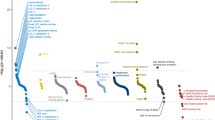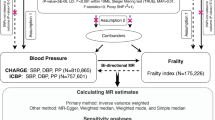Abstract
We recently identified rs3918226 as a hypertension susceptibility locus (−665 C>T), TT homozygosity being associated with higher hypertension risk. T compared with C allele transfected cells had lower endothelial nitric oxide synthase (eNOS) expression. In the family-based Flemish Study on Environment, Genes and Health Outcomes (50.9% women; mean age 40.3 years), we investigated whether 32 TT homozygotes had worse outcomes than 2787 C allele carriers. Over 15 years (median), total and cardiovascular mortality and cardiovascular and coronary events amounted to 269 (9.5%), 98 (3.5%), 247 (8.8%) and 120 (4.3%), respectively. While accounting for family clusters, the hazard ratios associated with TT homozygosity were 4.11 (P=0.0052) for cardiovascular mortality (4 deaths), 2.75 (P=0.0067) for cardiovascular events (7 endpoints) and 3.10 (P=0.022) for coronary events (4 endpoints). With adjustment for cardiovascular risk factors, these hazard ratios were 6.01 (P=0.0003), 2.64 (P=0.0091) and 2.89 (P=0.010), respectively. Analyses unadjusted for blood pressure and antihypertensive treatment produced consistent results. For all fatal plus nonfatal cardiovascular events, the positive predictive value, attributable risk and population-attributable risk associated with TT homozygosity were 21.9, 61.5 and 2.0%, respectively. In conclusion, TT homozygosity at the position −665 in the eNOS promoter predicts adverse outcomes, independent of blood pressure and other risk factors.
This is a preview of subscription content, access via your institution
Access options
Subscribe to this journal
Receive 12 digital issues and online access to articles
$119.00 per year
only $9.92 per issue
Buy this article
- Purchase on Springer Link
- Instant access to full article PDF
Prices may be subject to local taxes which are calculated during checkout

Similar content being viewed by others
References
Salvi E, Kutalik Z, Glorioso N, Benaglio P, Frau F, Kuznetsova T et al. Genome-wide association study using a high-density SNP-array and case-control design identifies a novel hypertension susceptibility locus in the promoter region of eNOS. Hypertension 2012; 59 (2): 248–255.
Salvi E, Kuznetsova T, Thijs L, Lupoli S, Stolarz-Skrzypek K, D'Avila F et al. Target sequencing, cell experiments and a population study established endothelial nitric oxide synthase (eNOS) gene as hypertension susceptibility gene. Hypertension 2013; 62 (5): 844–852.
Förstermann U, Sessa WC . Nitric oxide synthases: regulation and function. Eur Heart J 2012; 33 (7): 829–837.
Li H, Förstermann U . Nitric oxide in the pathogenesis of vacsular disease. J Pathol 2000; 190 (3): 244–254.
Staessen JA, Wang JG, Brand E, Barlassina C, Birkenhäger WH, Herrmann SM et al. Effects of three candidate genes on prevalence and incidence of hypertension in a Caucasian population. J Hypertens 2001; 19 (8): 1349–1358.
Stolarz-Skrzypek K, Kuznetsova T, Thijs L, Tikhonoff V, Seidlerová J, Richart T et al. on behalf of the European Project on Genes in Hypertension EPOGH) Investigators. Fatal and nonfatal outcomes, incidence of hypertension and blood pressure changes in relation to urinary sodium excretion in White Europeans. JAMA 2011; 305 (17): 1777–1785.
World Medical Association Declaration of Helsinki. Ethical principles for medical research involving human subjects. Bull World Health Organ 2001; 79 (4): 373–374.
Expert Committee on the Diagnosis and Classification of Diabetes Mellitus. Report of the expert committee on the diagnosis and classification of diabetes mellitus. Diabetes Care 2003; 26 (suppl 1): S5–S20.
Levey AS, Stevens LA, Schmid CH, Zhang Y, Castro AF III, Feldman HI et al. for the CKD-EPI (Chronic Kidney Disease Epidemiology Collaboration). A new equation to estimate glomerular filtration rate. Ann Intern Med 2009; 150 (9): 604–612.
Fay MP, Feuer EJ . Confidence intervals for directly standardized rates: a method based on the gamma distribution. Stat Med 1997; 16 (7): 791–801.
Holtzman NA, Marteau TM . Will genetics revolutionize medicine? New Engl J Med 2000; 343 (2): 141–144.
Hibi K, Ishigami T, Tamura K, Mizushima S, Nyui N, Fujita T et al. Endothelial nitric oxide synthase gene polymorphism and acute myocardial infarction. Hypertension 1998; 32 (3): 521–526.
Hingorani AD, Liang CF, Fatibene J, Lyon A, Monteith S, Parsons A et al. A common variant of the endothelial nitric oxide synthase (glu298—>asp) is a major risk factor for coronary artery disease in the UK. Circulation 1999; 100 (14): 1515–1520.
Tangurek B, Ozer N, Sayer N, Terzi S, Yilmaz H, Dayi SU et al. The relationship between endothelial nitric oxide synthase gene polymorphism (T-786 C) and coronary artery disease in the Turkish population. Heart Vessels 2006; 21 (5): 285–290.
The ALLHAT Officers and Coordinators for the ALLHAT Collaborative Research Group. Major outcomes in high-risk hypertensive patients randomized to angiotensin-converting enzyme inhibitor or calcium channel blocker vs diuretic. The Antihypertensive and Lipid-Lowering Treatment to Prevent Heart Attack Trial (ALLHAT). JAMA 2003; 288 (23): 2981–2997.
Zhang X, Lynch AI, Davis BR, Ford CE, Boerwinkle E, Eckfeldt JH et al. Pharmacogenetic associations of NOS3 variants with cardiovascular disease in patients with hypertension: the GenHAT Study. PLoS ONE 2012; 7 (3): e34217.
Rees DD, Plmer RMJ, Moncada S . Role of endothelium-derived nitric oxide in the regulation of blood pressure. Proc Natl Acad Sci USA 1989; 86 (9): 3375–3378.
Haynes WG, Noon JP, Walker BR, Webb DJ . Inhibition of nitric oxide synthesis increases blood pressure in healthy humans. J Hypertens 1993; 11 (12): 1375–1380.
Fleming I, Busse R . Molecular mechanisms involved in the regulation of the endothelial nitric oxide synthase. Am J Physiol Regul Integr Comp Physiol 2003; 284 (1): 1–12.
Stasch JP, Pacher P, Evgenov OV . Soluble guanylate cyclase as an emerging therapeutic target in cardiopulmonary disease. Circulation 2011; 123 (20): 2263–2273.
Ghofrani HA, D'Armini AM, Grimminger F, Hoeper MM, Jansa P, Kim NH et al. for the CHEST-1 Study Group. Riociguat for the treatment of chronic thromboembolic pulmonary hypertension. New Engl J Med 2013; 369 (4): 319–329.
Ghofrani HA, Galiè N, Grimminger F, Grünig E, Humbert M, Jing ZC for the PATENT-1 Study Group. Riociguat for the treatment of pulmonary arterial hypertension. New Engl J Med 2013; 369 (4): 330–340.
Nyholt DR . Genetic case-control association studies - correcting for multiple testing. Hum Genet 2001; 109 (5): 564–565.
Vittinghoff E, McCulloch CE . Relaxing the rule of ten events per variable in logistic and cox regression. Am J Epidemiol 2007; 165 (6): 710–718.
Acknowledgements
Mrs Annick De Soete and Mrs Sandra Covens provided expert clerical assistance. Sources of funding: Dr Laura Olivi was partly supported by student mobility Erasmus Placement Grant from the University of Milano. The European Union (grant FP7-HEALTH-2007-A-201550, and HYPERGENES provided financial support for the genotyping studies. The European Union InterOmics (PB05 MIUR-CNR Italian Flagship Project) supported the Department of Health Sciences-University of Milan. The European Union (grants IC15-CT98-0329-EPOGH, LSHM-CT-2006-037093-InGenious HyperCare, HEALTH-2007-2.1.1-2-HyperGenes, HEALTH-2011.2.4.2-2-EU-MASCARA, HEALTH-F7-305507 HOMAGE and the European Research Council Advanced Researcher grant-2011-294713-EPLORE) gave support to the Studies Coordinating Centre, Leuven, Belgium. The Fonds voor Wetenschappelijk Onderzoek Vlaanderen, Ministry of the Flemish Community, Brussels, Belgium (G.0881.13 and G.0880.13) also supported the FLEMENGHO study.
Author information
Authors and Affiliations
Corresponding author
Ethics declarations
Competing interests
The authors declare no conflict of interest.
Additional information
Supplementary Information accompanies this paper on the Journal of Human Hypertension website
Supplementary information
Rights and permissions
About this article
Cite this article
Olivi, L., Gu, YM., Salvi, E. et al. The −665 C>T polymorphism in the eNOS gene predicts cardiovascular mortality and morbidity in white Europeans. J Hum Hypertens 29, 167–172 (2015). https://doi.org/10.1038/jhh.2014.66
Received:
Revised:
Accepted:
Published:
Issue Date:
DOI: https://doi.org/10.1038/jhh.2014.66



